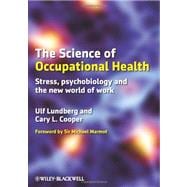
Note: Supplemental materials are not guaranteed with Rental or Used book purchases.
Purchase Benefits
What is included with this book?
| Preface | p. ix |
| Foreword | p. xi |
| Acknowledgements | p. xiii |
| Introduction: History of Work and Health | p. 1 |
| General background and aim | p. 1 |
| Work and health from an evolutionary perspective | p. 4 |
| About this book | p. 10 |
| The New Workplace in a Rapidly Changing World | p. 11 |
| Global economy and global competition | p. 11 |
| Flexible organisations - flexible workers | p. 13 |
| Health consequences of 'sickness presenteeism' | p. 15 |
| Rationalisation | p. 16 |
| Sources of stress at work | p. 17 |
| The New World of Work | p. 22 |
| Lean manufacturing and just-in-time production | p. 22 |
| Frequent restructuring | p. 24 |
| Lifelong learning, work and family-life balance | p. 25 |
| Long working hours and overtime | p. 27 |
| The role of modern communication technology and telecommuting: work without boundaries, or endless work | p. 29 |
| Diffuse distinction between work and other parts of life | p. 32 |
| The challenge for health and well-being in organisations in the future | p. 33 |
| A flexible workforce | p. 34 |
| Work as a Source of Stimulation and Health or a Cause of Distress and Illness | p. 41 |
| Work-related stress models | p. 41 |
| Justice | p. 45 |
| Positive and negative work | p. 45 |
| Job satisfaction | p. 47 |
| Workaholism | p. 48 |
| Type A behaviour | p. 49 |
| Job strain and heart disorder | p. 50 |
| Conclusion | p. 52 |
| Responses to Stress | p. 53 |
| Mind-body interaction | p. 53 |
| The neuroendocrine stress systems | p. 55 |
| The cardiovascular system | p. 57 |
| Coping with stress | p. 58 |
| Acute stress | p. 60 |
| Chronic stress | p. 66 |
| Short-term versus long-term stress | p. 68 |
| Importance of sleep | p. 68 |
| Allostatic load | p. 69 |
| Catabolic and anabolic processes | p. 73 |
| Stress-related Health Problems | p. 75 |
| Chronic fatigue, depression, burnout | p. 76 |
| Cardiovascular disorders | p. 78 |
| Immune function | p. 79 |
| Cognitive function | p. 81 |
| Obesity, diabetes - the metabolic syndrome | p. 82 |
| Musculoskeletal disorders | p. 84 |
| Ulcers | p. 89 |
| HIV, AIDS and cancer | p. 89 |
| When should I be worried? | p. 90 |
| How can any treatment be efficient? | p. 91 |
| Stress Hormones at Work | p. 92 |
| Socioeconomic Status and Health | p. 96 |
| Health Promotion | p. 102 |
| Health intervention, stress reduction | p. 102 |
| Managing stress in a changing workforce | p. 103 |
| Individual interventions | p. 104 |
| Healthy work | p. 106 |
| Mental capital and well-being | p. 109 |
| Interventions and policies | p. 111 |
| Physically risky jobs | p. 112 |
| Positive psychology | p. 112 |
| Restorative environments and recreation | p. 115 |
| Sleep | p. 117 |
| Physical activity | p. 118 |
| Gender Differences | p. 120 |
| Symptoms, health and life expectancy | p. 120 |
| Work tasks | p. 122 |
| Unpaid work and total workload | p. 126 |
| Children, women and stress | p. 128 |
| Preventive Strategies | p. 129 |
| Occupational hazards | p. 129 |
| Health promotion | p. 129 |
| Occupational conditions in Europe | p. 130 |
| Healthy work | p. 130 |
| SES and health | p. 131 |
| Work-life balance | p. 132 |
| What can we do to reduce stress? | p. 133 |
| Comments on preventive strategies | p. 134 |
| The Future Workplace from a Stress-Health Perspective | p. 135 |
| A changing world | p. 135 |
| Work and health | p. 136 |
| Stress, well-being and productivity | p. 138 |
| Demographic changes in Europe and Japan | p. 140 |
| Global issues | p. 141 |
| References | p. 145 |
| Index | p. 163 |
| Table of Contents provided by Ingram. All Rights Reserved. |
The New copy of this book will include any supplemental materials advertised. Please check the title of the book to determine if it should include any access cards, study guides, lab manuals, CDs, etc.
The Used, Rental and eBook copies of this book are not guaranteed to include any supplemental materials. Typically, only the book itself is included. This is true even if the title states it includes any access cards, study guides, lab manuals, CDs, etc.